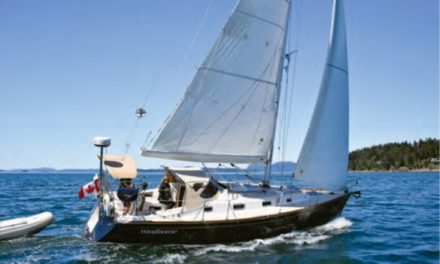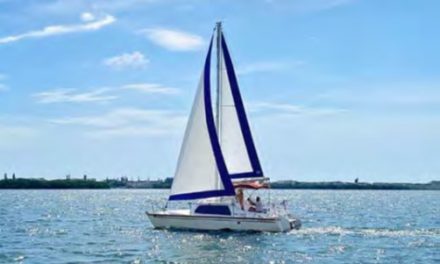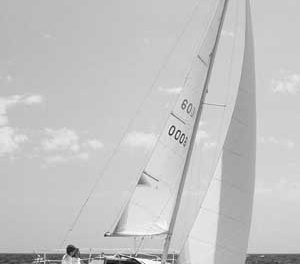A pert little catboat for daysailing and napping
Issue 153: Nov/Dec 2023
 Bob Ryan, 75, handed me his business card at Dock on the Bay Marina on Longboat Key, Florida. Below his name was his occupation — Retired. We were standing next to his recently purchased 2002 17-foot ComPac Sun Cat. After owning a Bristol 24 Corsair, Morgan Out Island 28, and a Catalina 30 over his sailing years, the snowbird from Chicago wanted a simple-to-sail, easy-to-maintain boat for daysailing on Sarasota Bay. He found it in the locally built Christine II on a trailer at the Sarasota Sailing Squadron, Sarasota’s community sailing center on neighboring Lido Key.
Bob Ryan, 75, handed me his business card at Dock on the Bay Marina on Longboat Key, Florida. Below his name was his occupation — Retired. We were standing next to his recently purchased 2002 17-foot ComPac Sun Cat. After owning a Bristol 24 Corsair, Morgan Out Island 28, and a Catalina 30 over his sailing years, the snowbird from Chicago wanted a simple-to-sail, easy-to-maintain boat for daysailing on Sarasota Bay. He found it in the locally built Christine II on a trailer at the Sarasota Sailing Squadron, Sarasota’s community sailing center on neighboring Lido Key.
The Sun Cat satisfied most, but not all, of his requirements. It has a small cabin for naps, a head, and quality construction. What it didn’t have, and what he didn’t fully appreciate until buying the boat, were lifelines. As a senior, when balance becomes an issue, one looks for security on deck. Fortunately, Bob hasn’t fallen overboard. Also, fortunately, there isn’t much reason to leave the cockpit unless anchoring.
Design and History
Clark Mills designed the Sun Cat; he is best known for designing the 7-foot 8-inch Optimist “Opti” dinghy, perhaps the most ubiquitous sail trainer in the country. He also built boats at Mills Boat Works, a shop he opened in Clearwater, Florida. Other Mills designs include the Windmill and several ComPac boats — the 16, 23, Sun Cat, and a variation called the Sunday Cat. Mills passed away in 2001 at age 86 and was inducted into the National Sailing Hall of Fame in 2017.
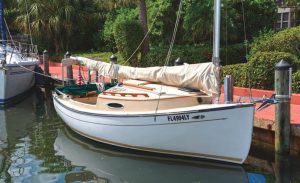
Sun Cat has shrouds port and starboard, which are integral to the Mastendr rig-raising-and-lowering system. As a cat rig, there is no backstay.
The Sun Cat design is a development of an earlier Mills design, the Dilks Sun Cat, for boatbuilder Dilks & Co. More than 500 Sun Cats have been built since the boat was introduced in 2000. The Sunday Cat, with a smaller cabin in exchange for a larger cockpit, followed in 2008.
The concept behind all catboats is severalfold: a shallow hull for shallow waters, hence the likelihood of a centerboard and so called barn door rudder to provide sufficient surface area in contact with the water without drawing much more than the hull itself; a single large sail for self-tacking and decent speed; and a generous beam for stability, as ballast is minimal, if present at all. The Sun Cat has 200 pounds in the stub keel, which also houses the centerboard in the up position.
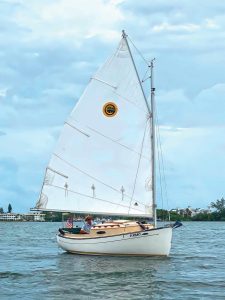
The Sun Cat does not have a large sail area, which means it needs a
little breeze to get going, but also does not need to be reefed too early. Photo: Charles Yeager
Com-Pac boats are built by the Hutchins Company, founded in 1957 by Les Hutchins, a tool and die maker. Its 12 models, which range from 14 to 35 feet, are all sailboats except for one power launch for leisurely harbor cruising. Of the 11 sailboats, six are catrigged and the rest are sloops. Besides Clark Mills, Bob Johnson (founder and past owner of Island Packet Yachts), and Charlie Morgan also contributed their design talents. The 20-foot Horizon Cat was designed by Halsey Herreshoff and was a development of the Herreshoff America trailerable sailboat, for which ComPac later acquired the tooling. Today, the business is operated by Les Hutchins’ sons, Gerry and Richard Hutchins.
Construction
The hull is singleskin fiberglass (no core), as is the deck. It has a stub keel with stainless steel centerboard, operated by a line and cam cleat on the cockpit floor. The early boats had a stainless steel box to house the board, but corrosion issues led to changing the structure to molded fiberglass. The conventional metal rudder is hinged to kick up if and when it hits bottom — in Florida, one can skip the “if.” There is an anchor locker at the bow. Ballast of 200plus pounds is concrete in the stub keel.
Gerry Hutchins describes how the hull and deck are joined: “The hull/deck joint is unusual for us. It is a system that Clark Mills designed into the boat. The hull has an inward flange, and the deck is flat so it rests on the inward flange. Screws are installed every 6 inches to hold the hull and deck together, and then the rub rail is installed with another set of screws that go between the original screws. Of course, there is liberal use of a marine adhesive sealant between the hull flange and the deck.”
Rig
The Sun Cat has a single sail of 150 square feet with a relatively short mast of roughly 16 feet, and a 9foot 1inch gaff that is raised with a separate halyard; both halyards are led aft to the coach roof. No winch assist is needed, though one owner said there seemed to be excessive friction raising his sail. When the sail is furled, the long, 13foot 7inch boom rests in the gallows at the aft end of the cockpit. There are several positions, allowing you to move the boom off to oneside so you can stand on the centerline.
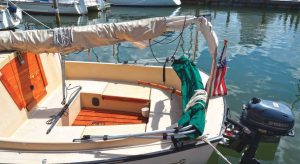
The cockpit comfortably seats three to four.
ComPac’s Mastendr quickrig sailing system makes raising and lowering the mast quick and effortless. The mast is light enough that once it is fixed to the tabernacle, you can walk/lift it upright. With shrouds attached, it is stable laterally. Fastening the forestay to the stem fitting with the selflocking lever secures the mast.
Gerry feels that the Mastendr is a great marketing feature, “People really appreciate the quickness and ease of that system,” he says. “It’s a hinge within the aluminum extrusion — the boom, sail, and gaff all push down below the hinge and rest on the boom gallows, then, with the forestay released, the spar is able to hinge back and rest on the boom gallows as well.” For trailering or dropping the rig to get under a low fixed bridge, this seems to be the ideal setup. Indeed, some owners say ease of raising and lowering the mast was a major reason for their purchase.
Accommodations
The interior is essentially a Vberth, or two settees with considerable foot space between. Under the companionway is a storage box that doubles as a step, and a portable toilet tucked under the cockpit that must be pulled out for use. A single battery is located in the forepeak, and on the main bulkhead is a small electrical distribution panel for cabin lights, nav lights, anchor light, and masthead light.
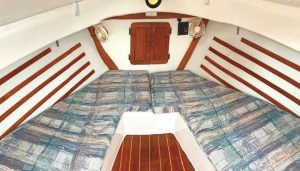
Owners say the berths are comfortable, if a bit narrow.
Teak strips along the hull sides add a touch of warmth to the fiberglass pan. It’s very clean and simple. Sleeping aboard for a night or several is entirely possible. The settee berths measure 6 feet 5 inches.
There is sitting headroom of 38 inches — enough unless you are leaning against the hull, as the sidedecks are low. Slouching solves the problem.
On Deck
The cockpit is wide and comfortable. Sitting aft, you can reach the outboard throttle and tiller and centerboard and sheet. There is no jib to worry about, so the only reason to go forward is to anchor. The sidedecks are narrow. Moving forward to anchor is a short distance; hang onto a shroud for your “one hand for the boat.” The boat will heel a bit but will not easily capsize.
Underway
We motored out of the marina at 3 to 4 knots, headed up and raised the mainsail with both gaff and sail halyards. Bob brought the peak of the gaff near to vertical. Falling off, we sailed downwind smoothly and swiftly, then reached back and forth across Cranes Bayou. When it was time to return to the marina, we headed up, but as expected, could not point very high. With no compass to gauge the tacking angle, we guessed it was probably 110 degrees, give or take. Speed was 4 to 5 knots.
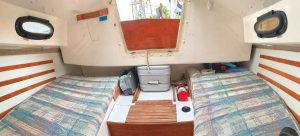
Looking aft, there is space for a portable toilet between the berths/settees and under the bridge deck. The hatches and opening portlights provide adequate ventilation.
The boat stalled if pressed too hard, and we had to fall off to gain speed before trying again. Don’t sheet the sail as tightly as you would a Marconi rig. When in the groove, however, she went upwind nicely and we made progress. To get the boat to point as high as possible, Rich Hutchins recommends bearing off a bit to gain hull speed and then bringing it up higher into the wind — without pinching. The boat’s light displacement meant she slowed quickly when depowered. To summarize comments from owners: The boat is slow and doesn’t point as high as a sloop, but they don’t care. It’s a catboat and performs as intended.
Conclusion
The Sun Cat is still in production, with a base sailaway price of $27,500. An online search showed used models built before 2008 ranging from around $8,000 to $16,750. We found a 2021 model for $29,500.
This boat is beautiful, simple, and fun. Don’t go too far downwind from your return destination. Reach back and forth, and enjoy lunch. The Sun Cat adequately meets its mission of easy daysailing and overnighting in very shoal waters.
Dan Spurr is a Good Old Boat contributing editor and editorat- large with Professional Boatbuilder. He is the author of seven books on boats and sailing including Heart of Glass, about the fiberglass boatbuilding industry, and was formerly senior editor at Cruising World and the editor of Practical Sailor.
Thank you to Sailrite Enterprises, Inc., for providing free access to back issues of Good Old Boat through intellectual property rights. Sailrite.com



